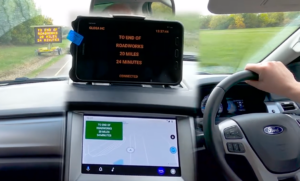Communication technologies allowing cars to intelligently interpret their surroundings and alert drivers to potential hazards, could reduce vehicle crashes by up to 78%, according to new research from the University of Melbourne.
The eight-month project involved a comprehensive analysis of traffic accident data in the state of Victoria between 2006 and 2019 using traffic micro-simulation studies from within the Australian Integrated Multimodal Ecosystem (AIMES).
Researchers focused on understanding cooperative intelligent transport system (C-ITS) technologies that would help drivers in eight main ways including; lane guidance, curve speed, collision avoidance, do not pass and blind spot warnings, intersection movement and right turn assistance, plus pedestrian safety messages.
This research – funded by iMOVE Cooperative Research Centre, the University of Melbourne, the Department of Infrastructure, Transport, Regional Development and Communications, and ITS Australia with support from IAG, Intelematics and Transmax – suggests the technology has the potential to “dramatically reduce trauma and the road toll”.
Professor Majid Sarvi, Lead of Transport Technologies at the University of Melbourne said “Our analysis of Victorian Road Safety data shows that with eight significant connected safety focuses, we have the ability to reduce the incidence of crashes by up to 78% and make vehicle transport safer for all road users.”
Professor Sarvi’s team of researchers including Dr Neema Nassir and Dr Patricia Sauri Lavieri found that curve speed warnings could have the most significant impact in rural areas.
52% of all fatal accidents occurred in rural Victoria, compared to 37 % of all fatal crashes occurring in urban areas of Melbourne.
Motorcyclists stand to derive the most benefit from curve warnings, as curve speed was a factor in 17% of crashes involving motorbikes, data shows.
C-ITS vehicle adaptations include cameras, ultrasonic or wireless sensors, antennas, 3D HD mapping capabilities, GPS, and Lidar which is a light pulsing laser device to accurately measure distances.
Professor Sarvi suggested that some technologies would become standard in new cars off the production line, while older vehicles could be retrofitted with aftermarket hardware.
The researchers pointed out that older vehicles involved in fatal crashes four times more frequently than newer cars. Data from ANCAP included as part of the overall study shows the oldest vehicles (built in 2001 or earlier) on Australian roads accounted for just 20% of the total national vehicle fleet but were over-represented in fatal crash data.
“1 in 5 cars on Victorian roads are considered older, but they are involved in 36% of all fatal crashes. By contrast, newer vehicles [built between 2012-2017] make up 31% of road vehicles but are involved in just 12% of fatal crashes,” Professor Sarvi said.
The rate of fatal crashes per registered vehicle for oldest vehicles was four times higher than that of newer vehicles.
ITS Australia CEO Susan Harris said, “This research shows the vital importance of transport technologies in both reducing road trauma and improving our transport networks.
“Supporting the deployment of these road safety and efficiency technologies is a key issue for ITS Australia and our members.”
(Picture – iMove Australia)






















